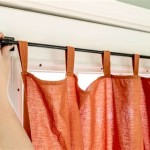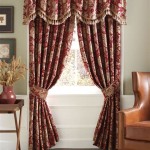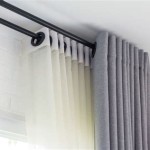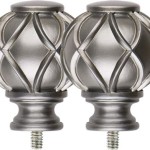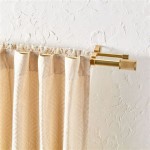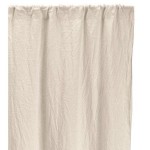Ideas for Kitchen Curtains: A Pinterest-Inspired Guide
Kitchen curtains are more than just window coverings; they are a crucial element in establishing the overall aesthetic and functionality of the kitchen. Choosing the right curtains can significantly impact the natural light, privacy, and visual appeal of this central space. Pinterest serves as a vast repository of design inspiration, offering a wealth of ideas for kitchen curtains catering to diverse tastes and kitchen styles. Navigating this extensive resource can be streamlined by understanding key considerations such as fabric choices, patterns, colors, and hardware options. This article explores various kitchen curtain ideas gleaned from Pinterest, providing a clear understanding of how to select the best curtains to enhance a kitchen's design and practicality.
Choosing the Right Fabric for Kitchen Curtains
The fabric selected for kitchen curtains has a significant influence on their durability, ease of maintenance, and overall aesthetic. Certain fabrics are more suitable for kitchens due to their resistance to moisture, stains, and sunlight. Considering the various fabric options is essential to ensure longevity and functionality in this high-traffic area.
Cotton: Cotton is a popular choice for kitchen curtains due to its affordability, versatility, and ease of cleaning. It is a breathable fabric that allows for good airflow, which is beneficial in a typically humid kitchen environment. Cotton comes in a wide range of weights and weaves, allowing for various levels of light filtration. Lightweight cotton fabrics like voile or muslin are ideal for sheer curtains that provide privacy while still allowing ample natural light to enter the kitchen. Heavier cotton fabrics, such as canvas or duck cloth, offer more privacy and durability. However, cotton is prone to shrinking and fading, so pre-washing or selecting pre-shrunk cotton is advisable. Regular washing is necessary to keep cotton curtains clean, as they can easily absorb cooking odors and stains.
Linen: Linen offers a more luxurious and sophisticated look compared to cotton. It is a natural fiber known for its durability, breathability, and unique texture. Linen curtains drape beautifully and add a touch of elegance to any kitchen. Like cotton, linen is suitable for a variety of curtain styles, from sheer panels to heavier drapes. It is also more resistant to fading than cotton, making it a good choice for kitchens that receive a lot of sunlight. However, linen is prone to wrinkling, which can be part of its charm, but may require ironing for a more polished look. Linen is also more expensive than cotton and may require professional cleaning to maintain its quality.
Polyester: Polyester is a synthetic fabric that is highly durable, wrinkle-resistant, and easy to care for. It is also resistant to moisture and stains, making it a practical choice for kitchen curtains. Polyester curtains come in a wide range of colors, patterns, and textures, allowing for versatile design options. They are often more affordable than natural fabrics like cotton or linen. Polyester is a good option for kitchens where durability and ease of maintenance are paramount. It is also a suitable choice for kitchens that experience high levels of humidity or sunlight, as polyester is less prone to fading or mildew. However, polyester is less breathable than natural fabrics and may not be as aesthetically pleasing to some.
Blends: Fabric blends, such as cotton-polyester or linen-polyester, offer a combination of the benefits of both fabrics. These blends can provide enhanced durability, wrinkle resistance, and ease of care while still retaining some of the natural texture and breathability of cotton or linen. Cotton-polyester blends are a popular choice, as they combine the affordability and versatility of cotton with the durability and wrinkle resistance of polyester. Linen-polyester blends offer a more luxurious look with improved wrinkle resistance. Fabric blends can be a cost-effective and practical option for kitchen curtains, offering a balance of aesthetic appeal and functionality.
Specialty Fabrics: In addition to the commonly used fabrics, there are specialty fabrics that can be suitable for kitchen curtains. These include oilcloth, which is water-resistant and easy to wipe clean, making it ideal for kitchens where spills are common. Vinyl is another water-resistant option that is durable and easy to maintain. However, oilcloth and vinyl may not be as aesthetically pleasing as other fabrics. For kitchens with specific needs, such as blackout curtains for blocking sunlight or insulated curtains for temperature control, there are also specialized fabrics available. These fabrics are typically thicker and may have a lining to provide added functionality.
Exploring Different Curtain Styles for Kitchens
The style of kitchen curtains not only affects the visual appeal but also influences the amount of light and privacy. Various curtain styles serve different purposes and complement different kitchen designs. Exploring these styles helps determine the most appropriate option for a specific kitchen setting.
Tier Curtains: Tier curtains, also known as café curtains, are short curtains that cover only the lower portion of the window. This style allows ample natural light to enter the kitchen while still providing privacy from street-level views. Tier curtains are often paired with a valance, which is a short decorative curtain that covers the top portion of the window. This combination offers a balanced look, providing both light and privacy. Tier curtains are particularly suitable for kitchens with a country, farmhouse, or cottage-style decor. They can be hung on a simple rod or with clip rings for a more casual look. Tier curtains are easy to install and maintain, making them a popular choice for many kitchens.
Valances: A valance is a short decorative curtain that covers the top portion of the window. Valances come in a variety of styles, including straight, gathered, pleated, and shaped. They can add a touch of elegance, whimsy, or rustic charm to a kitchen. Valances are often used in combination with other curtain styles, such as tier curtains or shades, to create a layered look. They can also be used alone to add a decorative element to the window without blocking too much light. Valances are particularly suitable for kitchens with a traditional or formal decor. They can be made from a variety of fabrics, including cotton, linen, silk, or blends. The choice of fabric and style of valance should complement the overall design of the kitchen.
Swag Curtains: Swag curtains are draped curtains that are typically hung over a decorative rod or pole. They add a touch of elegance and sophistication to a kitchen. Swag curtains can be made from a variety of fabrics, including silk, velvet, or linen. They are often used in formal kitchens or kitchens with a traditional decor. Swag curtains can be hung in a variety of ways, including cascading down the sides of the window or gathered in the center. They can also be combined with other curtain styles, such as sheers or valances, to create a more layered look. Swag curtains require more fabric than other curtain styles and may require professional installation.
Roman Shades: Roman shades are fabric shades that fold up into horizontal pleats when raised. They offer a clean and modern look and can be made from a variety of fabrics. Roman shades provide good light control and privacy. They are suitable for kitchens with a contemporary or minimalist decor. Roman shades can be mounted inside or outside the window frame. Inside-mounted shades offer a cleaner look, while outside-mounted shades can make the window appear larger. Roman shades are available in a variety of styles, including flat, hobbled, and relaxed. Flat Roman shades have a smooth, flat surface when lowered, while hobbled Roman shades have cascading folds. Relaxed Roman shades have a soft, flowing appearance. Roman shades require regular cleaning to prevent dust and dirt from accumulating in the pleats.
Roller Shades: Roller shades are fabric shades that roll up and down on a spring-loaded roller mechanism. They are a simple and functional option for kitchen windows. Roller shades provide good light control and privacy and are easy to operate. They are suitable for kitchens with a modern or minimalist decor. Roller shades can be made from a variety of fabrics, including vinyl, polyester, or natural fibers. Blackout roller shades are available for kitchens that require complete darkness. Roller shades are easy to install and maintain. They can be wiped clean with a damp cloth.
Sheer Curtains: Sheer curtains are lightweight curtains made from translucent fabrics, such as voile or chiffon. They allow ample natural light to enter the kitchen while still providing some privacy. Sheer curtains are often used in combination with other curtain styles, such as heavier drapes or shades, to create a layered look. They are suitable for kitchens that want to maximize natural light or that have a beautiful view. Sheer curtains can be hung on a simple rod or with clip rings for a more casual look. They are easy to clean and maintain, making them a practical choice for kitchen windows.
Incorporating Colors, Patterns, and Hardware
The color, pattern, and hardware choices for kitchen curtains play a significant role in the overall design and ambiance of the space. Selecting appropriate colors, patterns, and hardware can tie the entire kitchen design together and enhance its aesthetic appeal. Careful consideration of these elements is essential to achieve a cohesive and visually pleasing look.
Color Selection: The color of kitchen curtains should complement the existing color scheme of the kitchen. Neutral colors, such as white, beige, gray, or light blue, are versatile and can work well in a variety of kitchen styles. These colors create a light and airy feel and can make the kitchen appear larger. Bold colors, such as red, yellow, or green, can add a pop of color and energy to the kitchen. However, it is important to use bold colors sparingly to avoid overwhelming the space. Consider the undertones of the kitchen cabinetry and countertops when selecting curtain colors. Warm undertones pair well with warm colors, while cool undertones pair well with cool colors. Coordinating the curtain color with other elements in the kitchen, such as the backsplash, appliances, or accessories, can create a cohesive and harmonious look.
Pattern Choices: Patterns can add visual interest and personality to kitchen curtains. Small-scale patterns, such as polka dots, stripes, or floral prints, are suitable for smaller kitchens, as they do not overwhelm the space. Large-scale patterns, such as geometric prints or abstract designs, can make a statement in larger kitchens. Consider the style of the kitchen when selecting curtain patterns. Traditional kitchens often feature floral or damask patterns, while modern kitchens may feature geometric or abstract patterns. Patterns can also be used to tie together different colors in the kitchen. For example, a curtain with a pattern that incorporates the colors of the cabinetry and countertops can create a cohesive look. Avoid mixing too many different patterns in the kitchen, as this can create a cluttered and chaotic feel.
Hardware Options: The hardware used to hang kitchen curtains can also contribute to the overall design of the space. Curtain rods come in a variety of styles, materials, and finishes. Simple metal rods are a versatile option that can work well in a variety of kitchen styles. Decorative rods with ornate finials can add a touch of elegance to the kitchen. Wooden rods can add a rustic or farmhouse feel. The finish of the curtain rod should complement the other hardware in the kitchen, such as the cabinet pulls and faucet. Curtain rings or clips can also be used to hang kitchen curtains. Rings allow the curtains to glide easily along the rod, while clips offer a more casual and relaxed look. Consider the weight of the curtains when selecting hardware. Heavy curtains require sturdier rods and supports than lightweight curtains. Ensure that the hardware is securely mounted to the wall to prevent the curtains from falling down.
In conclusion, selecting the right kitchen curtains involves careful consideration of fabric, style, color, pattern, and hardware. By taking these factors into account, an individual can choose curtains that enhance the kitchen's aesthetic appeal, provide adequate light control and privacy, and complement the overall design of the space. Pinterest provides a wealth of inspirational ideas, but understanding these fundamental considerations ensures that the chosen curtains are both visually appealing and functionally appropriate for the unique needs of a kitchen.

100 Curtain Ideas To Dress Your Home Decoholic

48 Best Ideas For Kitchen Color Design Farmhouse Decor Curtains Renovation

32 Traditional Kitchen Ideas That Stand The Test Of Time

You Ll Love These Creative Ways To Dress Up A Kitchen Window

Best 25 Kitchen Curtains Ideas On Pinterest Window Treatments And Farmhouse

79 Best Cafe Curtains Ideas In 2025 Kitchen

Easy Affordable Diy Kitchen Window Valances

What A Difference Kitchen Curtains Make Modernize

15 Modern Kitchen Curtain Design Ideas With Pictures In 2024

Elegant Kitchen Curtain Ideas To Complement Your Culinary Space

